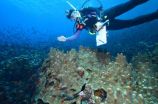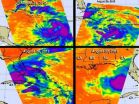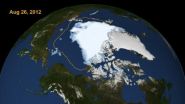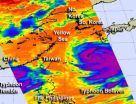(Press-News.org) All dietary fats are not created equal. Some types of fats have been linked to ailments like heart disease and diabetes, while others, like those often found in plants and fish, have well documented health benefits.
So why do our bodies respond so destructively to some fats but not others?
A new hypothesis described in latest issue of The Quarterly Review of Biology suggests the answer may lie in how different fats interact with the microbes in our guts. According to researchers from the University of New Mexico and Northwestern University, some fats may encourage the growth of harmful bacteria in the digestive system. Our bodies have evolved to recognize those fats and launch an immune response to preempt the impeding changes in harmful bacteria. The result is low-level inflammation that, over the long term, causes chronic disease.
"Although the inflammatory effects of [fats] are well documented, it is less well appreciated that they also influence bacterial survival and proliferation in the gastrointestinal tract," write the researchers, led by Joe Alcock, of the University of New Mexico Department of Emergency Medicine and VA Medical Center.
Some fats—mostly unsaturated fats—actually have strong antimicrobial properties. They react chemically with bacterial cell membranes, weakening them. "If you expose unsaturated fats on bacteria, the bacteria have a tendency to lyse. The combination of long chain unsaturated fats, especially omega-3 fatty acids, and innate host defenses like gastric acid and antimicrobial peptides, is particularly lethal to pathogenic bacteria," Alcock said. Saturated fats on the other hand generally lack those antimicrobial properties, and in fact can provide a carbon source that bacteria need to grow and flourish.
And it's these differing microbial effects, Alcock believes, that are at the root of why some fats are inflammatory and some aren't. To test that notion, the researchers poured through years of research on both the microbial effects of fats and their inflammatory effects.
"We found a highly significant relationship between those fats that had antimicrobial properties and those that had anti-inflammatory properties," Alcock said. "Fats that lack antimicrobial properties tended to be pro-inflammatory. It was a very, very strong relationship."
In a sense, the researchers say, the presence of saturated fats sets off an "early warning system" in the body. When fats that encourage bacterial growth are present, the body prepares for unwelcome microbial guests with an inflammatory immune response. And while that response may help fend off infection in the short term, the constant presence of such fats could cause the body to spiral into diseases related to inflammation, like heart disease.
The researchers caution that while this hypothesis is well supported by current data, there's much more research to be done.
"We have a pretty good idea that eating fatty foods encourages the growth and invasiveness of harmful microbiota and we know that certain fats kill off these potentially harmful species," Alcock said. "But we're making a bit of a leap from the Petri dish to the whole organism."
"We don't intend this to be the final word. Rather it's a tool to generate additional hypotheses that can be tested."
### Joe Alcock, Melissa L. Franklin, and Christopher W. Kuzawa, "Nutrient Signaling: Evolutionary Origins of the Immune-Modulating Effects of Dietary Fat." The Quarterly Review of Biology 87:3 (March 2013).
The premier review journal in biology since 1926, The Quarterly Review of Biology publishes articles in all areas of biology but with a traditional emphasis on evolution, ecology, and organismal biology. QRB papers do not merely summarize a topic, but offer important new ideas, concepts, and syntheses. They often shape the course of future research within a field. In addition, the book review section of the QRB is the most comprehensive in biology.
The Quarterly Review of Biology: Why some fats are worse than others
2012-08-28
ELSE PRESS RELEASES FROM THIS DATE:
Darwin discovered to be right: Eastern Pacific barrier is virtually impassable by coral species
2012-08-28
A coral species that is found in abundance from Indonesia eastward to Fiji, Samoa, and the Line Islands rarely crosses the Eastern Pacific Barrier toward the coast of the Americas, according to a team of researchers led by Iliana Baums, an assistant professor of biology at Penn State University. Darwin hypothesized in 1880 that most species could not disperse across the marine barrier, and Baums's study is the first comprehensive test of that hypothesis using coral. The results of the scientific paper, which will be published in the journal Molecular Ecology, has important ...
NASA infrared time series of Tropical Storm Isaac shows consolidation
2012-08-28
NASA's Atmospheric Infrared Sounder or AIRS instrument is an infrared "eye" that flies onboard NASA's Aqua satellite. AIRS has been providing the National Hurricane Center with valuable temperature data on Isaac's clouds and the surrounding sea surface temperatures, and a time series of data shows that Isaac is consolidating.
The AIRS instrument has been monitoring Tropical Storm Isaac for several days. AIRS data from Aug. 24, 25, 26 and 27 showed Isaac's movements through the eastern and central Caribbean Sea, across eastern Cuba and into the Gulf of Mexico. On Aug. ...
Rising cardiovascular incidence after Japanese earthquake 2011
2012-08-28
Munich, Germany – August 27 2012: The Japanese earthquake and tsunami of 11 March 2011, which hit the north-east coast of Japan with a magnitude of 9.0 on the Richter scale, was one of the largest ocean-trench earthquakes ever recorded in Japan. The tsunami caused huge damage, including 15,861 dead and 3018 missing persons, and, as of 6 June 2012, 388,783 destroyed homes.
Following an investigation of the ambulance records made by doctors in the Miyagi prefecture, close to the epicentre of the earthquake and where the damage was greatest, cardiologist Dr Hiroaki Shimokawa ...
Panda preferences influence trees used for scent marking
2012-08-28
As solitary animals, giant pandas have developed a number of ways to communicate those times when they are ready to come into close contact. One means of this communication occurs through scent marking. A recent study by San Diego Zoo Global researchers, collaborating with researchers at the Institute of Zoology, Chinese Academy of Science, indicates that pandas make clear and specific choices about what trees are used for scent marking.
"Variables affecting the selection of scent-marking sites included bark roughnesss, presence of moss on the tree trunk, tree diameter ...
Arctic sea ice shrinks to new low in satellite era
2012-08-28
The extent of the sea ice covering the Arctic Ocean has shrunk. According to scientists from NASA and the NASA-supported National Snow and Ice Data Center (NSIDC) in Boulder, Colo., the amount is the smallest size ever observed in the three decades since consistent satellite observations of the polar cap began.
The extent of Arctic sea ice on Aug. 26, as measured by the Special Sensor Microwave/Imager on the U.S. Defense Meteorological Satellite Program spacecraft and analyzed by NASA and NSIDC scientists, was 1.58 million square miles (4.10 million square kilometers), ...
WSU researcher documents links between nutrients, genes and cancer spread
2012-08-28
PULLMAN, Wash.—More than 40 plant-based compounds can turn on genes that slow the spread of cancer, according to a first-of-its-kind study by a Washington State University researcher.
Gary Meadows, WSU professor and associate dean for graduate education and scholarship in the College of Pharmacy, says he is encouraged by his findings because the spread of cancer is most often what makes the disease fatal. Moreover, says Meadows, diet, nutrients and plant-based chemicals appear to be opening many avenues of attack.
"We're always looking for a magic bullet," he says. "Well, ...
A greener way to fertilize nursery crops
2012-08-28
This press release is available in Spanish.
A U.S. Department of Agriculture (USDA) scientist has found a "green" alternative to a type of fertilizer additive that is believed to contribute to the accumulation of heavy metals in waterways.
Ornamental nursery and floral crops require micronutrients like iron, manganese, copper and zinc. But fertilizers that provide these micronutrients often include synthetically produced compounds that bind with the micronutrients so they are available in the root zone.
The most commonly used compounds, known as chelating agents, ...
George Washington University Computational Biology Director solves 200-year-old oceanic mystery
2012-08-28
WASHINGTON — The origin of Cerataspis monstrosa has been a mystery as deep as the ocean waters it hails from for more than 180 years. For nearly two centuries, researchers have tried to track down the larva that has shown up in the guts of other fish over time but found no adult counterpart. Until now.
George Washington University Biology Professor Keith Crandall cracked the code to the elusive crustacean's DNA this summer. His findings were recently published in the journal "Ecology and Evolution," and his research was funded by the National Science Foundation and the ...
NASA sees Typhoon Bolaven dwarf Typhoon Tembin
2012-08-28
NASA satellites are providing imagery and data on Typhoon Tembin southwest of Taiwan, and Typhoon Bolaven is it barrels northwest through the Yellow Sea. In a stunning image from NASA's Aqua satellite, Bolaven appears twice as large as Tembin.
NASA's Moderate Resolution Imaging Spectroradiometer (MODIS) instrument that flies onboard the Terra satellite captured a remarkable image of Typhoon Tembin being dwarfed by giant Typhoon Bolaven at 0240 UTC on Aug. 27, 2012. The visible image shows that the island of Taiwan appears to be squeezed between the two typhoons, while ...
Plants unpack winter coats when days get shorter
2012-08-28
EAST LANSING, Mich. — Mechanisms that protect plants from freezing are placed in storage during the summer and wisely unpacked when days get shorter.
In the current issue of the Proceedings of the National Academy of Sciences, Michael Thomashow, University Distinguished Professor of molecular genetics, demonstrates how the CBF (C-repeat binding factor) cold response pathway is inactive during warmer months when days are long, and how it's triggered by waning sunlight to prepare plants for freezing temperatures.
The CBF cold response pathway was discovered by Thomashow's ...



